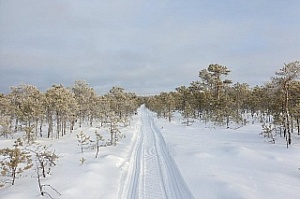Researchers from Tomsk State University and Newcastle University will study the carbon cycle of the Vasyugan Swamp. The first step towards this will be holding seminars necessary for the scientific groups’ adaptation. The British Science and Innovation Network, which supports the creation of international research projects, allocated a grant to the British side for these events.
- The Vasyugan Swamp attracts the attention of many scientific groups in the world, says Sergey Kirpotin, director of the TSU Center for Excellence Bio-Сlim-Land. - The reason lies not only in its size but also in the fact that this swamp plays a large climate-forming role. Studying it helps to understand the causes of global environmental changes that are occurring on the planet. British colleagues came to us through the publications of members of the SecNet network, created under the auspices of TSU to study Siberia and the Arctic. Specialists from Newcastle were interested in the megaprofile, a research infrastructure created by TSU. We, in turn, are interested in several laboratory studies that the British side is capable of performing.
A grant from the UK Science and Innovation Network won by Newcastle University staff will help researchers build a working relationship. In February, TSU scientists will go to the first joint seminar. They will deliver samples taken in the Vasyugan swamp for laboratory tests. The expedition to the largest swamp in the world took place in December.
- Winter sampling is fraught with certain difficulties, but we managed to get a peat column for research, namely, for the British side to conduct a lignin analysis, says Sergey Kirpotin. - This will help us obtain more accurate data on the presence of woody vegetation in the past, and, ultimately, on the carbon cycle, on which a lot depends on our planet. It was the long-term change in the carbon cycle in the distant past that led to the alternation of ice ages and warm interglacials. To predict further changes on the planet, it is very important to understand the laws of the processes that took place in the past.
The winter expedition was also interesting because it made it possible to assess the working conditions in the cold season. Previously, TSU scientists traveled along the Vasyugan Swamp on a swamp buggy in the summer, but it is almost impossible to cross the entire heavily watered and muddy place on this transport in the summer. The winter is different. Now, under the leadership of Sergey Fedko, the director of the stationary research base Vasyuganskaya, they were getting there on snowmobiles through the frozen swamp. This made it possible to select the locations for subsequent sampling.
The complexity of the route to Vasyugan Swamp is that there are no more than three points of entry from the taiga to the lake and only a few know them. This serves as a kind of protection for a unique object, within which the Vasyugan reserve will soon be created.
Also, in February 2020, scientists from Newcastle University will pay a return visit, during which they will visit two TSU research stations included in the SecNet network and the international project Interact II. During the seminars, researchers will discuss the topic of joint research and decide on the filing of joint applications to scientific foundations that support international projects.

